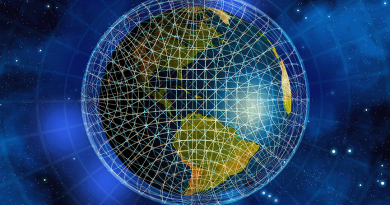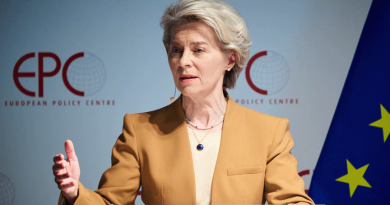Global economic fracturing
Bruno Casella is Senior Economist, Investment and Enterprise Division, Richard Bolwijn is Head of Investment Research, Division on Investment and Enterprise, both at the United Nations Conference on Trade and Development, and Francesco Casalena is a PhD student at the Geneva Graduate Institute (IHEID)
The trends stemming from technological advances, policy shifts, and the sustainability imperative, along with the effects of the trade tensions starting in late 2017 and the shock of the COVID pandemic, have sparked a debate on the risk of a reversal of economic globalisation (Fajgelbaum et al 2020, Antràs 2020, Zhan et al 2020, Kukharskyy et al 2021, Baldwin 2022a, 2022b, 2022c, 2022d).
The subsequent shocks of conflicts and political fragmentation have brought to the fore the heightened pressure towards global economic fracturing and the decoupling of global value chain (GVC) links between the US and other developed economies and the Chinese economy, with implications for many other countries and regions (Campos et al 2023, Aiyar et al 2023, Javorcik et al 2023).
So far, this debate has mainly focused on the trade perspective (Aiyar et al 2023 is an exception). The objective of this study is to explore the investment angle, offering a comprehensive reference for policymakers and analysts on the main trends reshaping the global FDI landscape amidst global economic fracturing. Given the intertwined nature of trade and FDI in the global production landscape dominated by GVCs, it also aims to build a much-needed bridge between connected narratives in the FDI and trade areas.
The underlying analysis owes credit to, and is directionally consistent with, previous studies investigating specific aspects of the FDI trends, particularly various recent editions of UNCTAD’s World Investment Reports (eg. UNCTAD 2017, 2020, 2021). However, to date, a fully integrated diagnostic covering both short- and long-term perspectives, as well as the sectoral, geographical, and bilateral dimensions of FDI patterns, has been lacking.
This column highlights ten empirical FDI trends, grouped into three overarching themes: the triple divergence, the rise of economic fracturing and the implications for sustainability and development (UNCTAD 2024). These trends fundamentally alter the development paradigm based on promoting investment in manufacturing and export-led growth, as will be discussed in the concluding part.
Triple divergence
Over the past two decades, FDI patterns have adapted to the transformative shifts reshaping economic globalisation in three key aspects.
1. Divergence between trends in FDI and GVCs and trends in GDP and trade. Historically closely intertwined under the common shaping force of GVCs, global trends in FDI and GVCs and in GDP and trade have been growing apart since the 2010s. While global GDP and trade have continued to grow steadily, cross-border investment and GVCs are coping with a long-term stagnation (FDI trend #1).
2. Divergence in FDI trends between services and manufacturing. FDI’s long-term stagnation is characterised by starkly divergent trajectories between rapidly growing investment in services (FDI trend #2) and shrinking investment in manufacturing activities (FDI trend #3) (Figure 1).
The transition from manufacturing to services is part of a broader change in the role of FDI in global value creation, whereas crossborder investment is moving from the centre to the two ends of the smile curve (FDI trend #4). This major shift is involving developed and developing economies alike, blurring the traditional boundaries in terms of their FDI sectoral footprints (FDI trend #5).
3. Divergence in FDI trends between China and the rest of the world. Chinese share in cross-border greenfield projects has been consistently declining for two decades, with an acceleration after the pandemic.
Despite a waning interest from multinational corporations in initiating new investment projects in China, the country continues to maintain a dominant position in global manufacturing and trade. Far from downsizing, ‘Global Factory China’ is changing its operational model from globally integrated to more domestically focused production networks, while still maintaining its leadership in global trade (FDI trend #6).
Since the escalation of the trade war – with an acceleration after the outbreak of the pandemic and the recent geopolitical crisis – escalating international tensions are turning divergence into fracturing
Figure 1. Diverging FDI trends in manufacturing and services
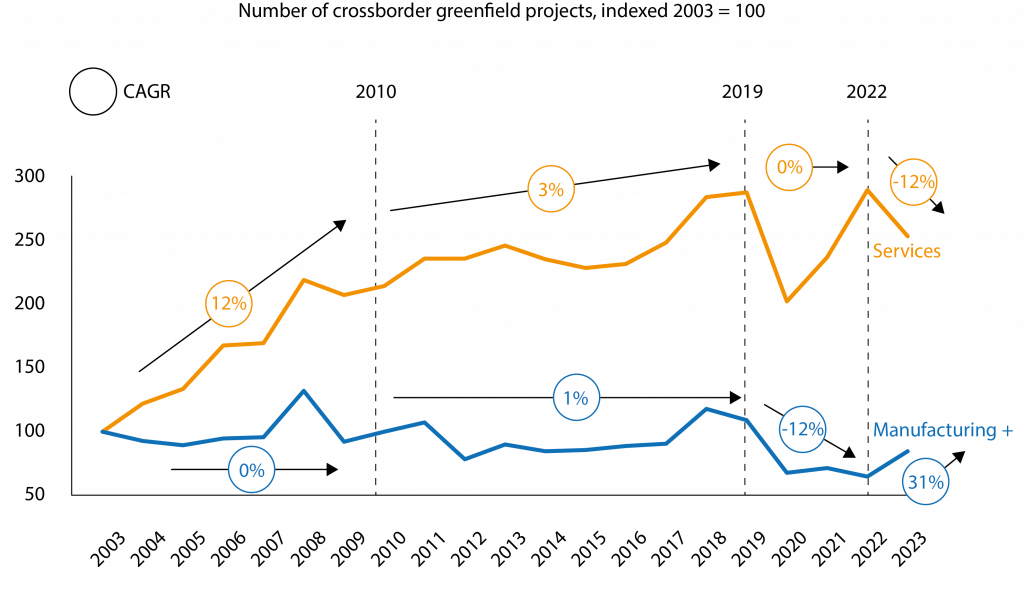
Note: CAGR: Compound Annual Growth Rate. The sectoral analysis is based on the variable ‘Business Activity’ from fDi Markets. ‘Manufacturing+’ includes ‘Manufacturing’ and ‘Other non-services’ activities. The latter group comprises the following categories: construction, electricity, extraction and infrastructure.
Source: UNCTAD, based on information from the Financial Times Ltd, fDi Markets (www.fDimarkets.com).
From divergence to fracturing
Since the escalation of the trade war – with an acceleration after the outbreak of the pandemic and the recent geopolitical crisis – escalating international tensions are turning divergence into fracturing, leading to the disruption of historical investment patterns. Fracturing is associated with heightened uncertainty and unpredictability in the FDI landscape, and limited possibilities for countries to strategically benefit from diversification (FDI trend #7).
The fracturing process is characterised by the rising importance of geopolitics. Overall, between 2013 and 2022, the share of FDI projects between geopolitically distant countries decreased by 10 percentage points, from 23% to 13% (figure 2). Geopolitical motivations are thus emerging as primary drivers of investment decisions, at times overriding traditional FDI determinants (FDI trend #8).
Figure 2. Declining share of FDI between geopolitically distant countries
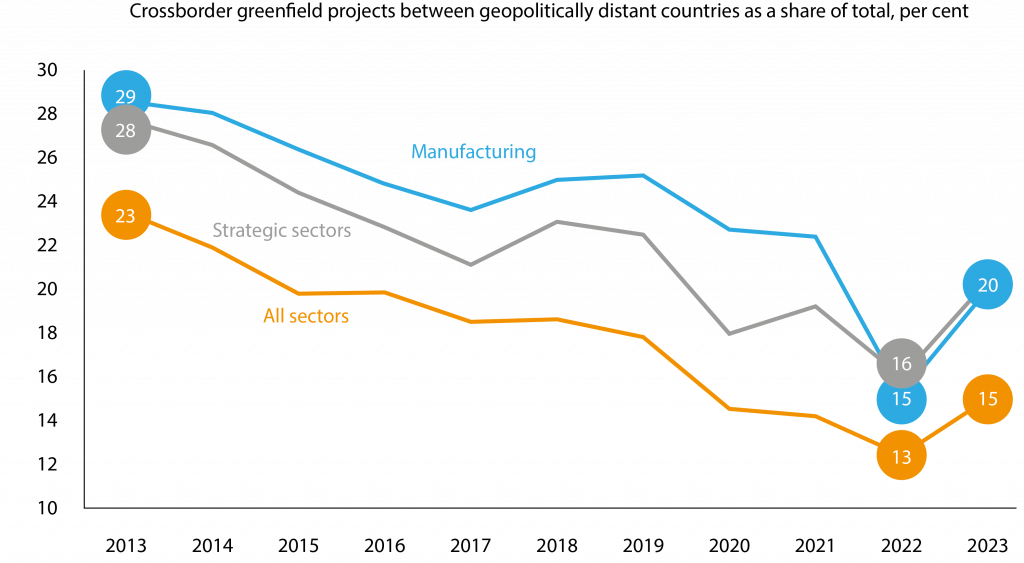
Note: The classification ‘Strategic sectors’ follows IMF (2023). Assessment of geopolitical alignment is based on United Nations voting patterns (Bailey et al 2017). The findings remain robust under alternative definitions of geopolitical groupings.
Source: UNCTAD, based on information from the Financial Times Ltd, fDi Markets (www.fDimarkets.com).
Sustainability push, but marginalisation of developing countries
Amid long-term stagnation of manufacturing investment across all industries, the number of crossborder greenfield projects in renewable energy generation (environmental technologies) as well as in the manufacturing of batteries and electric vehicles (EVs) has steadily increased (Figure 3).
The sustainability imperative and the drive to stimulate investment in the Sustainable Development Goals (SDGs) have opened new opportunities for investment in industrial development (FDI trend #9). However, these new opportunities can only compensate in part for the lack of FDI growth in other industrial sectors that are critical for GVC development strategies.
Historical shifts and economic fracturing are leading to a decrease in the share of FDI in smaller developing countries and least developed countries. This trend exacerbates their marginalisation and vulnerability, as FDI becomes increasingly concentrated in developed and emerging economies (FDI trend #10).
Figure 3. Growth of green FDI
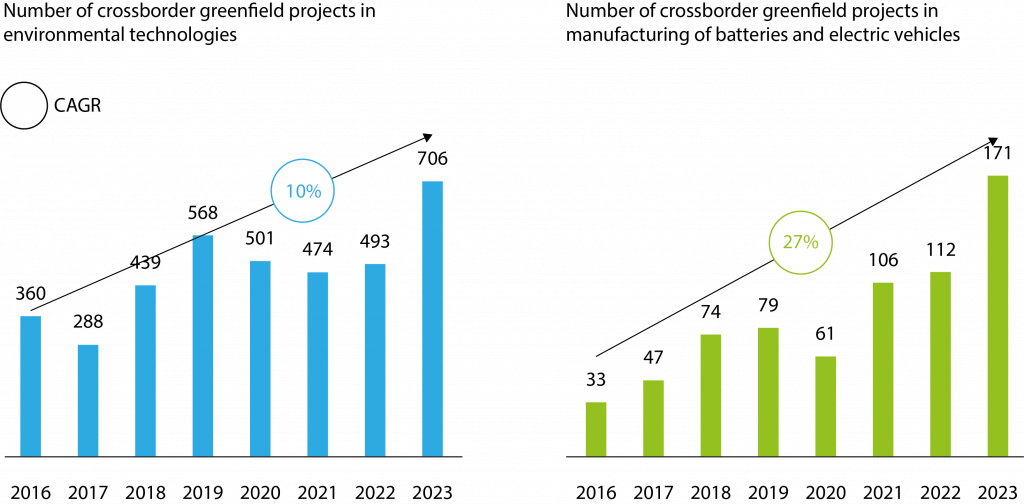
Note: CAGR: Compound Annual Growth Rate.
Source: UNCTAD, based on information from the Financial Times Ltd, fDi Markets (www.fDimarkets.com).
Conclusions: rethinking the FDI-GVC-development nexus
Based on a diagnostic of ten trends in foreign direct investment, in this column we put forward three major implications for developing countries and their development and industrialisation strategies.
First, the long-term stagnation of investment in GVCs and the sectoral shifts in investment patterns fundamentally alter the development paradigm based on promoting investment in manufacturing and export-led growth. These shifts affect the prospects for developing countries to increase their GVC participation and to gradually upgrade to higher value-added industrial activities.
The GVC development ladder – a concept developed in UNCTAD’s World Investment Report 2013 (UNCTAD 2013) – is becoming harder to climb as the least developed countries face declining manufacturing investment and a shrinking pool of efficiency-seeking, lower value-added projects to leverage for GVC participation (Figure 4).
Second, changes in the patterns of sources and destinations of investment due to global economic fracturing, de-risking, and resilience trends can bring opportunities for some countries, but are a challenge for most. They not only reinforce the effects of the long-term trends but also introduce new complexity into international production and increased uncertainty for both investors and investment policymakers as geopolitical considerations become more important FDI determinants.
Third, the ongoing marginalisation of countries at the lower levels of the GVC development ladder, combined with diminishing opportunities in traditional GVC-intensive industries, requires investment policymakers in these countries to intensify their search for investment promotion opportunities in sectors that are less reliant on GVCs.
This includes industries where growth is driven by policy factors other than those influencing the general trend in GVCs. Notably, the promotion of investment in environmental technologies and sustainable energy serves as a notable example, albeit not the only one (UNCTAD 2023).
Figure 4. The GVC development ladder: Shifting FDI weights
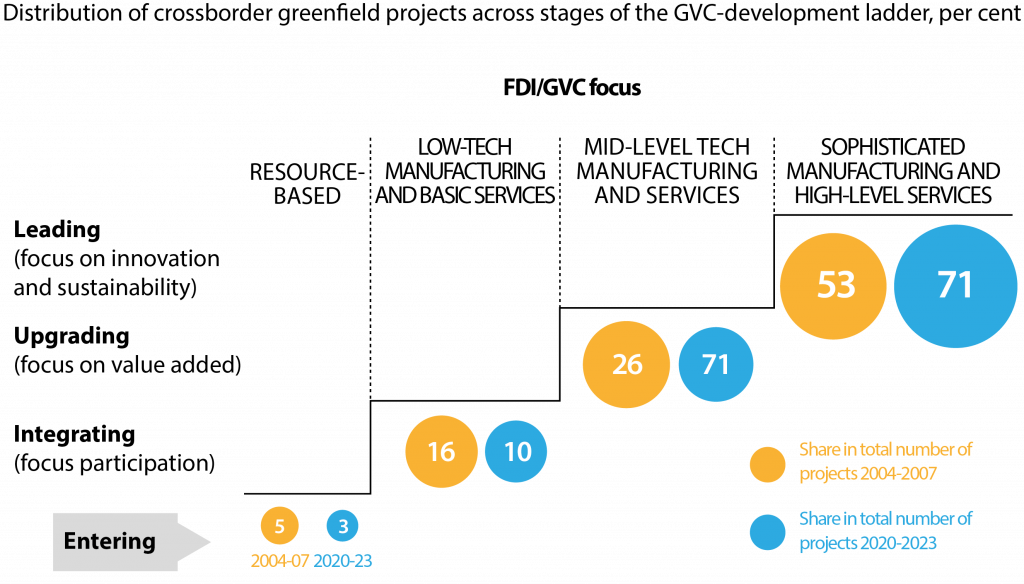
Note: The classification of projects along the ladder is based on fDi Markets variables ‘Business Activity’ and ‘Cluster’ and Lall’s technological classification (Lall 2000, Sturgeon and Gereffi 2009).
Source: UNCTAD, building on the concept developed in UNCTAD World Investment Report 2013 (pages 179-181); project shares based on information from the Financial Times Ltd, fDi Markets (www.fDimarkets.com).
References
Aiyar, S, D Malacrino and A Presbitero (2023), “Investing in Friends: The Role of Geopolitical Alignment in FDI Flows”, CEPR Discussion Paper No. 18434.
Antràs, P (2020), “De-Globalisation? Global Value Chains in the Post-COVID-19 Age,” CEPR Discussion Paper No. 15462.
Baldwin, R (2022a), “The peak globalization myth: Part1”, VoxEU.org, 31 August.
Baldwin, R (2022b), “The peak globalization myth: Part2 – Why the goods trade ratio declined,” VoxEU.org, 1 September.
Baldwin, R (2022c), “The peak globalization myth: Part3 – How global supply chains are unwinding”, VoxEU.org, 2 September.
Baldwin, R (2022d), “The peak globalization myth: Part4 –Services trade did not peak,” VoxEU.org, 3 September 2022.
Bailey, M, A Strezhnev and E Voeten (2017), “Estimating dynamic state preferences from United Nations voting data,” Journal of Conflict Resolution 61(2): 430-456.
Blanchard, E J, A Santos-Paulino, C Trentini and E Milet (2021), “Implications of rising trade tensions for FDI projects”, Transnational Corporations 28(2): 161-183.
Campos, R, JE Flores, D Furceri and J Timini (2023), “Geopolitical fragmentation and trade,” VoxEU.org, 31 July.
Fajgelbaum, PD, P Goldberg, PJ Kennedy and A Khandelwal (2020), “The return to protectionism,” The Quarterly Journal of Economics 135(1): 1–55.
IMF (2023), “Chapter 4: Geoeconomic fragmentation and foreign direct investment,” in World Economic Outlook: A rocky recovery.
Javorcik, B, L Kitzmueller, H Schweiger and A Yıldırım (2022), “Economic costs of friend-shoring,” EBRD Working Paper No. 274.
Kukharskyy, B, G Felbermayr, O Krebs and P Eppinger (2021), “Decoupling from global value chains,” VoxEU.org, 7 July.
Lall, S (2000), “The Technological structure and performance of developing country manufactured exports, 1985-98,” Oxford Development Studies 28(3): 337-369.
Sturgeon, TJ and G Gereffi (2009), “Measuring success in the global economy: international trade, industrial upgrading, and business function outsourcing in global value chains,” Transnational Corporations 18(2): 1-36.
UNCTAD (2013), World Investment Report 2013: Global Value Chains: Investment and Trade for Development.
UNCTAD (2017), World Investment Report 2017: Investment and the Digital Economy.
UNCTAD (2020), World Investment Report 2020: International Production Beyond the Pandemic.
UNCTAD (2021), World Investment Report 2021: Investing in Sustainable Recovery.
UNCTAD (2023), World Investment Report 2023: Investing in Sustainable Energy for All.
UNCTAD (2024), Global economic fracturing and shifting investment patterns.
Zhan, J, B Casella, A Santos-Paulino and R Bolwijn (2020), “Global value chain transformation to 2030: Overall direction and policy implications,” VoxEU.org, 13 August.
This article was originally published on VoxEU.org.


